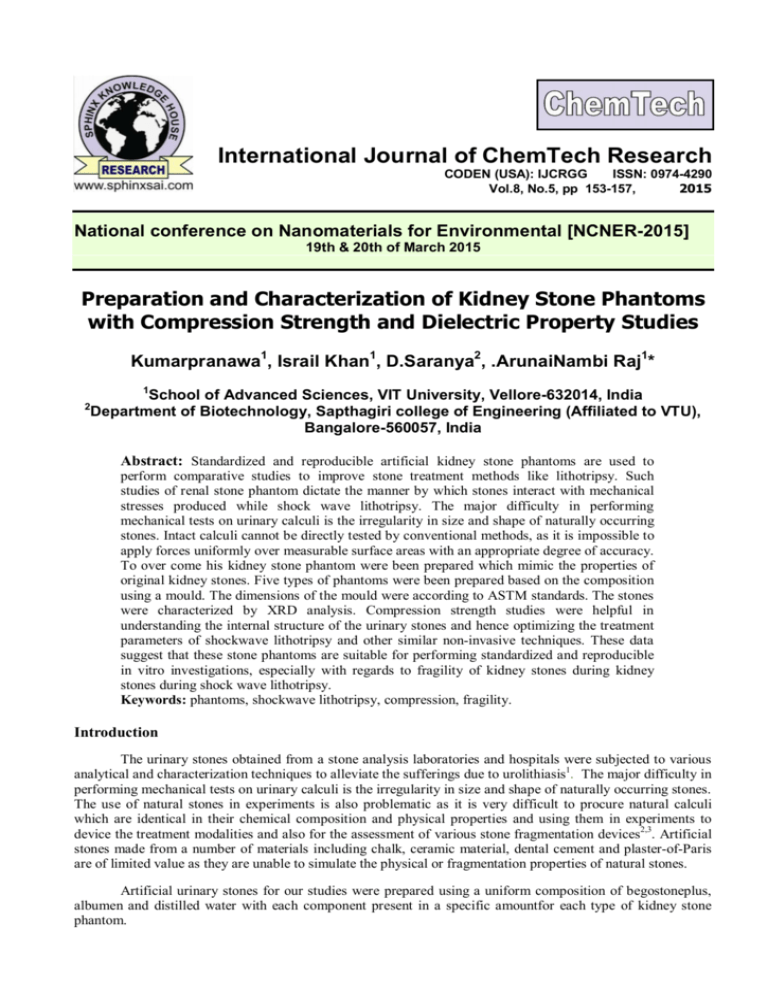Preparation and Characterization of Kidney Stone Phantoms with
advertisement

International Journal of ChemTech Research CODEN (USA): IJCRGG ISSN: 0974-4290 Vol.8, No.5, pp 153-157, 2015 National conference on Nanomaterials for Environmental [NCNER-2015] 19th & 20th of March 2015 Preparation and Characterization of Kidney Stone Phantoms with Compression Strength and Dielectric Property Studies Kumarpranawa1, Israil Khan1, D.Saranya2, .ArunaiNambi Raj1* 1 School of Advanced Sciences, VIT University, Vellore-632014, India Department of Biotechnology, Sapthagiri college of Engineering (Affiliated to VTU), Bangalore-560057, India 2 Abstract: Standardized and reproducible artificial kidney stone phantoms are used to perform comparative studies to improve stone treatment methods like lithotripsy. Such studies of renal stone phantom dictate the manner by which stones interact with mechanical stresses produced while shock wave lithotripsy. The major difficulty in performing mechanical tests on urinary calculi is the irregularity in size and shape of naturally occurring stones. Intact calculi cannot be directly tested by conventional methods, as it is impossible to apply forces uniformly over measurable surface areas with an appropriate degree of accuracy. To over come his kidney stone phantom were been prepared which mimic the properties of original kidney stones. Five types of phantoms were been prepared based on the composition using a mould. The dimensions of the mould were according to ASTM standards. The stones were characterized by XRD analysis. Compression strength studies were helpful in understanding the internal structure of the urinary stones and hence optimizing the treatment parameters of shockwave lithotripsy and other similar non-invasive techniques. These data suggest that these stone phantoms are suitable for performing standardized and reproducible in vitro investigations, especially with regards to fragility of kidney stones during kidney stones during shock wave lithotripsy. Keywords: phantoms, shockwave lithotripsy, compression, fragility. Introduction The urinary stones obtained from a stone analysis laboratories and hospitals were subjected to various analytical and characterization techniques to alleviate the sufferings due to urolithiasis1. The major difficulty in performing mechanical tests on urinary calculi is the irregularity in size and shape of naturally occurring stones. The use of natural stones in experiments is also problematic as it is very difficult to procure natural calculi which are identical in their chemical composition and physical properties and using them in experiments to device the treatment modalities and also for the assessment of various stone fragmentation devices2,3. Artificial stones made from a number of materials including chalk, ceramic material, dental cement and plaster-of-Paris are of limited value as they are unable to simulate the physical or fragmentation properties of natural stones. Artificial urinary stones for our studies were prepared using a uniform composition of begostoneplus, albumen and distilled water with each component present in a specific amountfor each type of kidney stone phantom. ArunaiNambi Raj et al /Int.J. ChemTech Res. 2015,8(5),pp 153-157. 154 Depending on the ratio of BegoStone and water, five types of phantoms such as oxalate, cystine, Magnesium ammonium phosphate hexahydrate/Carbonate apatite, calcium hydrogen phosphate dihydrate and uric acid were prepared.However preparing artificial model of each prominent type of kidney stone and analysing the mechanical properties of each model type will be very useful in providing appropriate data for selecting optimum treatment modalities for lithotripsy and other related non invasive stone treatment methods. They dictate how a stone interacts and disintegrates with mechanical forces produced by shock wave and laser lithotripsy techniques 2.The kidney stone phantom was prepared using mould. The mould was designed using 3D CAD model.The mould prepared was such that the artificial stones prepared using that was of exact dimension and shape. This requirement was essential because for each specific study a proper shape and size is required as per ASTM standard. Several different urinary components are capable of precipitating in the renal tract and serving as the building blocks of kidney stones4 .Accurate knowledge of the qualitative and quantitative composition of urinary calculi is vital for understanding their etiology and for the development of prophylactic measures5. One of the most common methods of calculi analysis is X-ray diffraction. The detection limit of X-ray diffraction is generally about 5%6. FTIR analysis gives the exact functional group information about the compound through which the material considered for analysis can becharacterized. Then flexural strength study was performed on the prepared model using universal testing machine.Compressive strength is the maximum stress a material can sustain under crush loading.Compressive strength is calculated by dividing the maximum load by the original cross-sectional area of a specimen in a compression test7, 8.The dielectric constant of a solid is a property, which depends on the presence of atoms and molecules and their arrangements. The mechanism of the growth of hard biological tissues such as kidney and gall stones as well as their identification also requires an understanding of their dielectric properties 9,10. Also dielectric properties of urinary stones are important because urinary stones are made up of organic material, mainly, collagen, and inorganic materials like calcium oxalates, hydroxyapatite and other phosphates11. Material and methods The study was carried out by preparing phantoms using a material called Begostone. Other materials required for phantom preparation were water, albumin.By varying the composition of water and Begostone five different stone types were prepared namely Oxalate, Cystine, MAPH/CA, CHPD, Uricacid. The mould to prepare the stone phantom was designed using 3D CAD model. The mould was filled with Begostone plus, distilled water and albumen that have been uniformly mixed together. The stone phantom obtained was with the dimension 75 mm* 10 mm *10 mm. The phantom obtained was slowly heated to 90 and held at this temperature for 12 hours to polymerize the albumen. Phantom preparation: To prepare kidney stone phantom begostone plus, distilled water and albumen was mixed uniformly. Mixing the above three in a particular ratio produced a particular type of stone phantom. In this way five different types of stone samples were produced by mixing the above three materials in five specific composition[Table 1]. After five different types of stone phantoms were prepared, they were filled in mould. After the stone had acquired the proper shape by keeping the prepared stone in mould for nearly 24 hours, the prepared stone phantom were taken out. Table 1: Composition for stone phantom that mimic the mid range fracture stresses of common human kidney stone types. Stone type Oxalate Cystine MAPH/CA CHPD UA Begostone (wt%) 82 73 66 81 72 Water (wt%) 15.5 24.5 31.5 16.5 25.5 Protein (wt%) 2.5 2.5 2.5 2.5 2.5 ArunaiNambi Raj et al /Int.J. ChemTech Res. 2015,8(5),pp 153-157. 155 XRD data of the stone phantoms were analyzed.For compression study , the shape of the sample was rectangular with 15 mm diameter and 25 mm height. For dielectric study flat rectangular sample with length 10 mm and width 5 mm was prepared. (a) (b) Fig 1: stone phantoms for (a) dielectric (b) compression Compression study: The study was carried out using Universal Testing Machine (UTM) Tinius Olsen, Model H5KS, UK with load range 5 kN, displacement range 5 mm, speed 0.2 mm/minute, height 25 mm, break detect 10% , autoreturn off and preload 0 N. The sample diameter was 15 mm and height 25 mm. Fig 2: Universal Testing Machine Dielectric property study: The prepared urinary stone phantom were dried at room temperature and the prepared artificial stones cut into a rectangular slabs with parallel flat surfaces were coated with silver paint and subjected to dielectric studies. The dielectric measurements namely capacitance, dielectric loss coefficient (tan δ), impedance and resistance were taken for the urinary stones samples in the frequency range from 1 Hz to 1 MHz with the supply voltage of one volt a.c. at room temperature using the impedance analyzer, HIOKI MODEL 3835-50 LCR Hi Tester. The readings were taken also for frequency range of 1 Hz to 1 MHz with the supply voltage of one volt a.c. for different temperatures for artificial stones. Dielectric constant(er) was calculated using the formula, ArunaiNambi Raj et al /Int.J. ChemTech Res. 2015,8(5),pp 153-157. 156 Cd Ae 0 eo = absolute permittivity in the free space having a value of 8.854 × 10−12 Fm−1, A=area in m2, d=thickness(m) C=capacitance (F) of the material at the particular frequency. er = From the above observed and calculated values, the alternating current conductivity was also calculated using the formula, σac = 2πfeoertanδ f=frequency, tan δ =dielectric loss measured directly from the impedance analyzer. Results: XRD Analysis Compression analysis 5000 F O R C E (N ) 4000 OXALATE CYSTINE MAPH CHPD UA 3000 2000 1000 0 -0.2 0.0 0.2 0.4 0.6 0.8 1.0 1.2 1.4 1.6 EXTENSION(mm) Fig3: Discussion and Conclusion XRD analysis: Existing kidney stone phantomsdo not contain insoluble organic material in combination withan inorganic matrix. The inorganic component of the presentcomposite phantom stones was BegoStone Plus, which isessentially a strengthened gypsum plaster. The spacingwas reduced which made the sample harder. FTIR analysis: Compression strength analysis: The maximum compression strength was found for oxalate and minimum was found for MAPH/CA. The order of compression strength was as follows Oxalate > CHPD > Cystine > Uric acid > MAPH. The graph plotted was between amount of force applied by the machine on the sample and the amount of extension the samples undergoes without breaking. Compressive strength of eachstone wasapproximately ten times greater than its tensile strength. ArunaiNambi Raj et al /Int.J. ChemTech Res. 2015,8(5),pp 153-157. 157 Dielectric properties: The dielectric properties of kidney stone phantoms were performed. It was found that parameters like impedance, conductance, inductance and dielectric loss coefficient were more affected at lower frequencies. However at higher frequencies these parameters were almost constant or near to zero. Since shock wave lithotripsy involves use of electrical and shock waves, so it very necessary to know thebehaviour of each type of kidney stones phantoms at different frequencies. Such data will again bevery helpful in optimizing the treatment parameters of shock wave lithotripters and related non invasive treatment methods. References: 1. 2. 3. 4. 5. 6. 7. 8. 9. 10. 11. 1. N.P. Cohen and Whitefield(1993). Mechanical testing of urinary calculi, Department of urology, St.Brtholomew’Hospital ,West Smithfield ,London ,EC1A,England,UK. A. Mohamed Ali and N. ArunaiNambi Raj,(2008). Tensile, flexural and compressive strength studies on natural and artificial phosphate urinary stones, SpringerVerlagUrological research, Vol. 36,pp 289295. A. Mohamed Ali , N. ArunaiNambi Raj, S.KalainathanP.Palanichamy(2007).Microhardness and acoustic behaviour of calcium oxalate monohydrate urinary stone,Material Letters 62(2008) pp.23512354. D.Heimbach,R. Munver, P.Zhong and C. Muller, (2000). Acoustic and mechanical properties of artificial stones in comparison to natural kidney stones, The Journal of Urology, Vol. 164, pp.537-544. L.G. Johrde, F.H. Cocks (1985). Fracture strength studies of renal calculi, Journals of material science letters, Vol. 4 , pp. 1264-1265. W.N. Simmons, F.H. Cocks, P. Zhong and Glenn Preminger,(2010). A composite kidney stone phantom with mechanical properties controllable over the range of human kidneystones, Journal of the mechanical behaviour of biomedical materials, Vol. 3 pp. 130-133. Yunbo Liu and Pei Zhong(2010). BegoStone—a new stone phantom for shock wave lithotripsy research, Journal of acoustic society of America, Vol. 112, No. 4, pp.1265/4 A. Mohamed Ali , N. ArunaiNambi Raj, S.Kalainathan ,P.Palanichamy(2006).Ultrasonioc studies on artificial kidney stone models, Journal of pure applications of ultrasonic, Vol. 28, pp. 73-80. R. Agarwal and V.R. Singh(1990). A comparative study of fracture strength, ultrasonic properties and chemical constituents of kidney stones, Ultrasonic, Vol. 29, pp. 88-90. V.R. Singh.R.Agarwal and S.P. Sud(1988).Ultrasonic Propagation in kidney stones,Indian journal of pure and Applied Physics,Vol. 26, pp. 475-476 T.H. Flournoy, F.H. Cock and J. Affronti(1991). Fracture strength of human gallstones, Journal of material science letters, Vol. 10, pp. 1066-1068. *****





